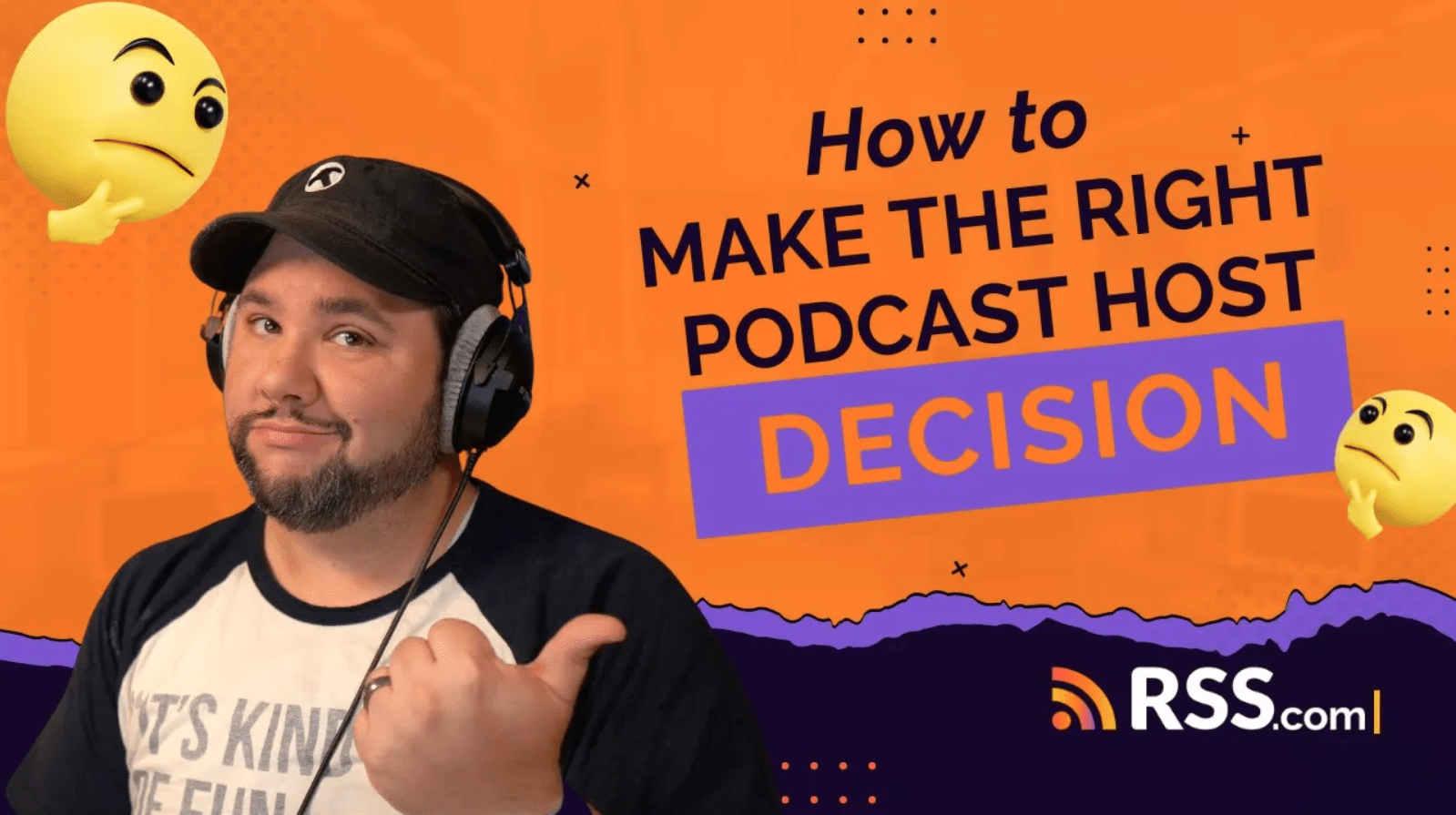Ready to start your own podcast?
With so many podcast hosting options available, finding the right host can feel overwhelming.
You’re likely asking yourself:
- How do I choose the best host for my needs and budget?
- Which features do I need now?
- What will I need as my podcast grows?
- How do I make money from my podcast?
This guide was created to help you find the podcast hosting platform that perfectly meets your goals, budget, and future plans for your show.
🤔 What Should You Be Looking For in a Podcast Host?
Podcasters at every level should expect their podcast hosting service to:
- Make it easy to start, grow and promote your show
- Offer multiple pricing plans to meet different needs and budgets
- Provide cross-platform, real-time analytics to track your podcast’s performance and growth
- Offer monetization options to help you make money
- Provide you with tools to promote and distribute your podcast to the top listening apps like Apple Podcasts, Spotify, Amazon Music, YouTube and more
Now that we’ve covered the essential features you’ll need and want as a new podcaster, let’s look at what makes the top podcast hosting platforms different.
🍿 Prefer to watch? Check out the video below!
The Best Podcast Hosting Services in 2025
1. RSS.com

RSS.com has quickly emerged as one of the most popular podcast hosting platforms for both new and established podcasters.
Its affordability, essential features for growth, user-friendly interface, and incredible customer support make it a top choice – especially for new podcasters just getting started.
With RSS.com, you’ll get everything you need to start, track, promote, and make money from your podcast.
For all the features you get, RSS.com is one of the most affordable hosting options and the best value for your money.
RSS.com offers a completely free Local and Niche plan with unlimited episodes and unlimited audio storage. Unlike other free hosting options that limit monthly uploads or delete old episodes, RSS.com’s free plan has no restrictions. You get automatic distribution to all major podcast apps, a free podcast website, listener funding tools, analytics and more at no cost.
For podcasters who need advanced features like programmatic advertising, Apple Podcasts Subscriptions, or support for multiple shows, paid plans start at just $11.99/month (paid annually).
Some of the standout features of RSS.com include:
- Automatic and Guided Distribution: Effortlessly distribute your podcast to major directories like Spotify, Apple Podcasts, Amazon Music and YouTube.
- Free AI-Generated Episode Transcripts: Available on all paid plans, you can use these transcripts to enhance your promotional efforts.
- Audio-to-Video Conversion: Convert your audio episodes into videos and upload them directly to YouTube from your dashboard for YouTube Podcasts.
- Detailed, Real-Time Analytics: Get insights into your audience and track your podcast’s performance.
- Free Podcast Website: Get a dedicated, customizable website that showcases all your episodes.
- Multiple Show Hosting: Want to have more than one podcast? With RSS.com, you can manage multiple podcasts from a single account with ease.
- User-Friendly Interface: Set up new shows in about five minutes, making it incredibly easy to get started.
- Monetization Options: Explore opportunities such as sponsorships, Apple Podcast Subscriptions, and PAID (Programmatic Ads Inserted Dynamically) with just 10 downloads per month.
- Privacy Protection: Your email address will be removed from the public RSS feed to prevent unwanted spam.
- Collaboration Features: Add collaborators (Admins and Analysts) to streamline your podcast management.
RSS.com offers incredible value for your money, and the best part is that you can start for free, add unlimited episodes, and explore most of the features it has to offer.
Note: Some RSS.com features are only available on the paid plans including the audio to video YouTube integration, AI generated transcripts, and the PAID monetization feature.
RSS.com Is Easy to Use
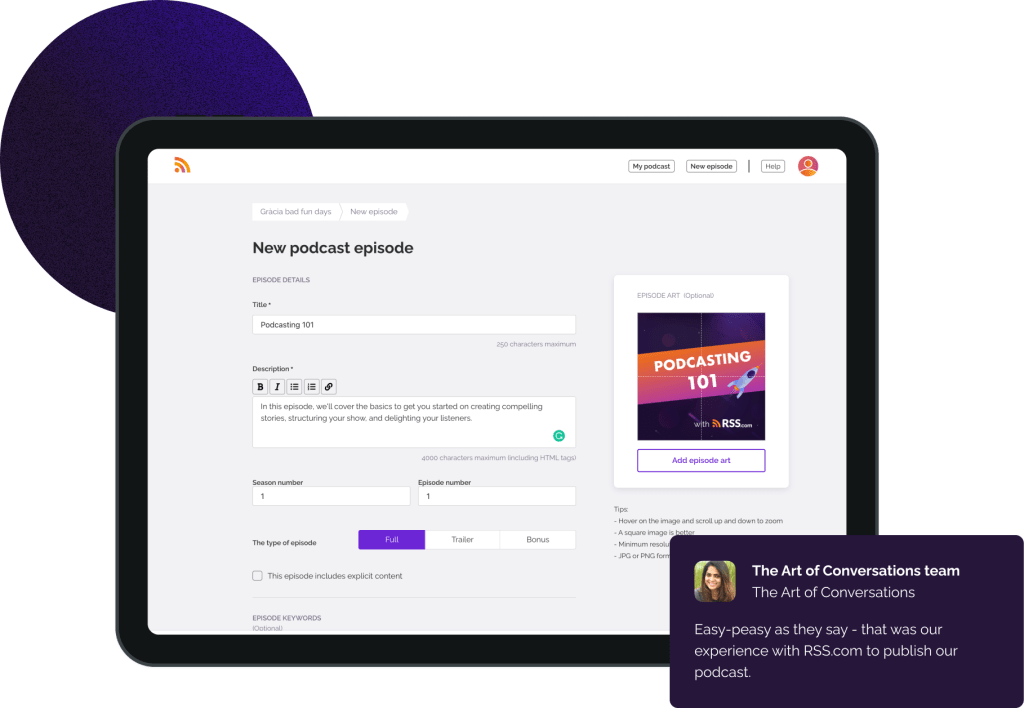
RSS.com allows podcasters to easily manage their shows with its simple, intuitive interface that can be accessed on desktop, smartphones and tablets.
RSS.com is so easy to use that new shows can be up and running in less than 3 minutes. Check out the video below to see how easy podcasting can be!
RSS.com gives all of it’s users a free podcasting website that’s automatically updated with your latest episodes.
You can customize your podcast’s website with cover, episode and chapter art as well a show description and links to an external website and or donation platform.
Auto-Submission of Your Podcast to Spotify, Apple Podcasts & Amazon Music
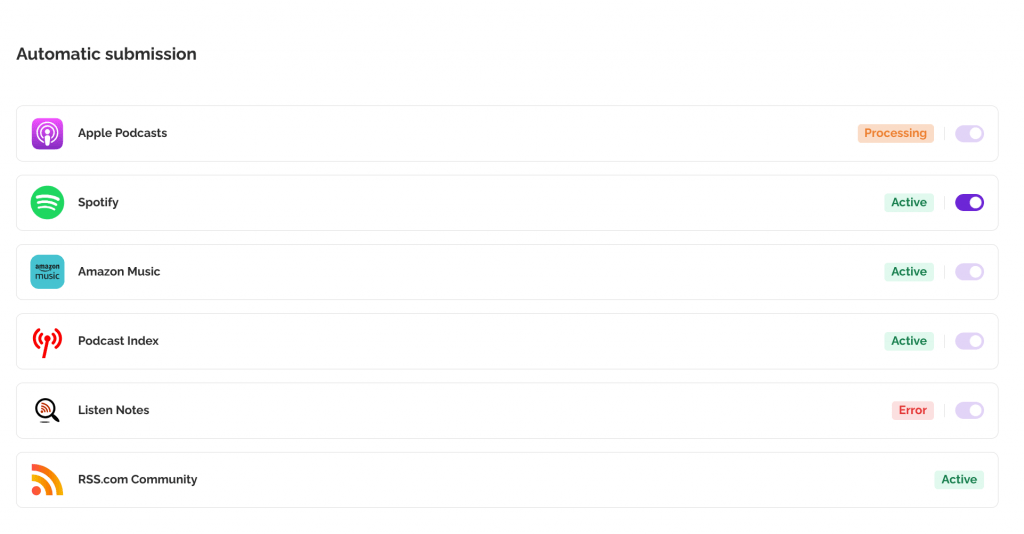
The easiest way to get your podcast in front of new followers and fans is to submit it to the major podcast directories.
One incredibly valuable feature that RSS.com has that top competitors like BuzzSprout don’t is automatic distribution to the top podcast directories like Spotify, Apple Podcasts, Amazon Music and more.
What is automatic distribution? It simply means you sync your account and all your episodes will be automatically distributed to these top directories.
AI-Powered Episode Transcripts
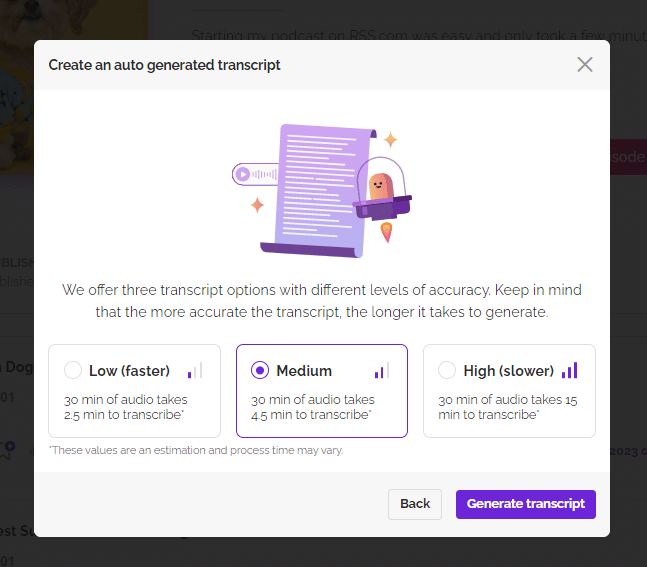
Another useful feature that many podcast hosting platforms charge for but that RSS.com includes in all paid plans is episode transcriptions.
You can use transcripts to not only make your show more accessible but more visible. When you publish your transcripts as notes or a blog post, you give search engines like Google text to crawl which can help your show surface in Google Search.
✨ Episode transcriptions are an easy way to increase you show’s visibility and engagement!
Cross-Platform Analytics

Understanding your audience is key to improving and growing your podcast. With RSS.com’s IAB certified Podcast Analytics, you’ll get access to:
- Total number of subscribers for the month
- Number of all-time downloads (including how many downloads there were today, yesterday, this month and the previous month)
- Your top five episodes
- Where people are listening from geographically
- Device trends over time
- The app used to listen
- Heatmap showing the most popular listen days and times for your show
With IAB analytics certification, RSS.com podcasters gain reliable, industry-standard data, enabling them to confidently optimize audience insights, secure sponsorships, and improve engagement.
Easily Convert Your Audio Podcast Episodes into Videos for YouTube Podcasts
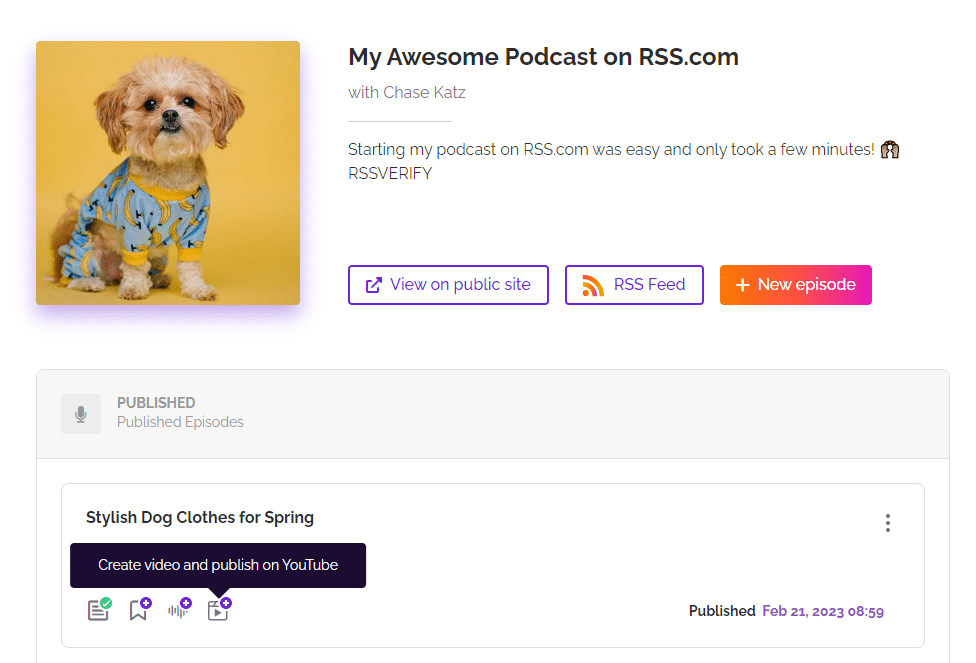
RSS.com provides 1-click audio-to-video conversion of your podcast episodes and also allows you to sync your channel for automatic publishing to YouTube.
Embeddable Podcast Player
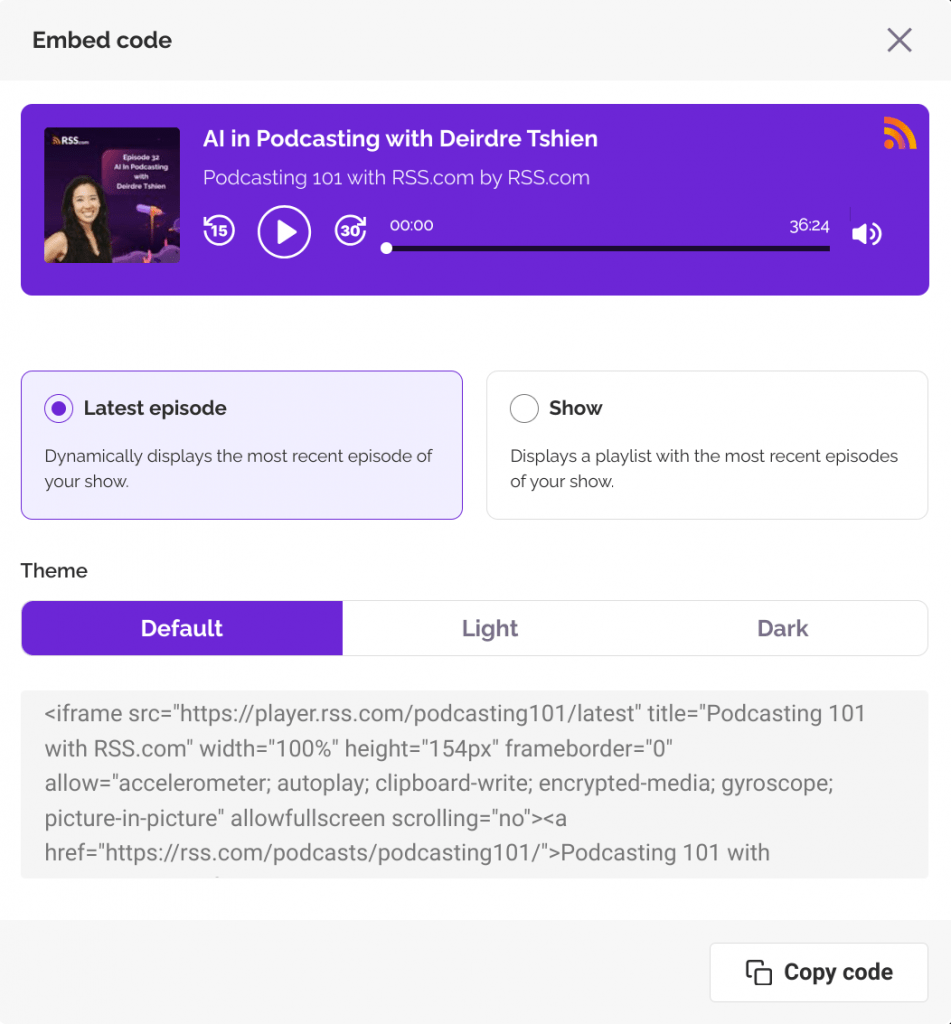
RSS.com offers a customizable embeddable podcast player so you can embed your episodes directly into your blog posts or website to attract more listeners and fans. You can embed a single episode or even your entire show!
PROS
- Free Local and Niche plan with unlimited episodes and storage.
- No monthly upload limits or episode deletion (even on free plan).
- Paid plans start at just $11.99/month (annual) for advanced features.
- RSS.com is easy to use. You can start a new show in under 5 minutes.
- Unlimited episodes.
- Free episode transcriptions.
- Unlimited downloads.
- Ability to add and manage multiple podcasts through one account.
- Cross-platform, IAB certified analytics that allows you to better understand your audience and content.
- Convert your audio episodes into videos for YouTube Podcasts and automatically published your converted episodes onto your YouTube channel.
- PAID (Programmatic Ads Inserted Dynamically) with just 10 downloads per month
- Monetization options via Apple Podcasts Subscriptions and sponsorships.
- Free, podcast website for your show that’s updated automatically.
- Episode scheduling feature.
- Ability to add custom cover art to your public profile pages and episodes.
- Automatic creation and update of a fully-compliant podcast RSS feed compatible with all major podcast directories including Spotify, Apple Podcasts, Amazon Music and more.
- Automatic and guided distribution of your show and episodes in all the major podcast directories.
- Annual plans save 25% on paid tiers ($11.99/month for All in One, $18.75/month for Podcast Networks).
- Automatic show distribution to PodcastIndex, and Listen Notes.
- Educational discounts. Students and teachers receive a 60% discount on monthly pricing. Learn more about Educational plans here.
- Community podcast directory for additional discovery and SEO visibility of your show.
- Excellent customer service and support.
- Episode player embed feature for easy sharing and promotion of your episodes.
- Easy, 1-click social media sharing of your show and episodes on Twitter, Facebook, LinkedIn, and Pinterest.
- Lock tags to minimize the possibility of unauthorized copies of your RSS feed.
- Ability to add donation and website links to your public podcast website.
- Removal of your email address from your public RSS feed to enhance privacy and eliminate spam.
- Option to add Admins and Analysts to your podcast to simplify the management of your show.
- Podroll feature: you can recommend up to six other podcasts right that will be prominently displayed on your public RSS.com podcast website.
CONS
- Unlike some podcast hosting providers, RSS.com doesn’t have an app that allows you to record your show and publish episodes instantly.
- Not all Podcasting 2.0 tags available at this time.
- Customer Support and UI only available in three languages and via email.
- RSS.com does not offer WordPress plugins.
- RSS.com unlimited free plans don’t include all features.
- RSS.com does not have a mobile app.
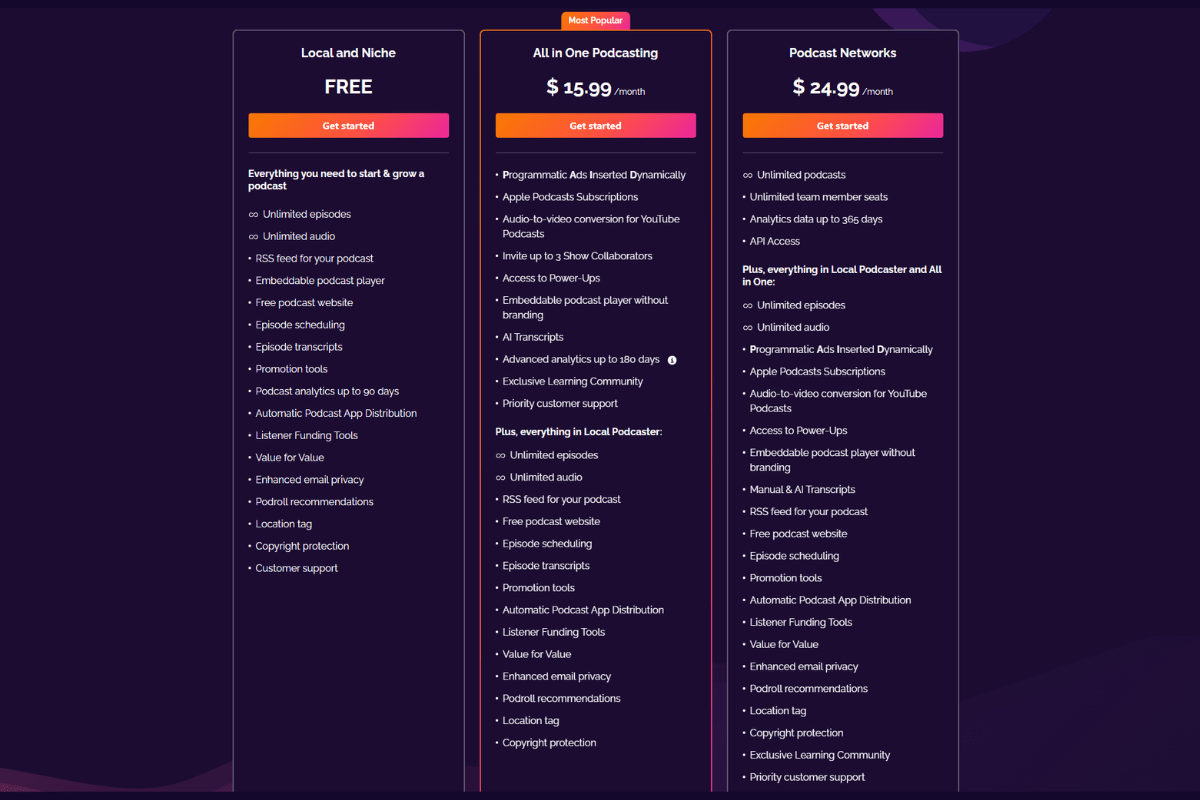
2. Blubrry

What draws some podcasters to Blubrry Podcasting is PowerPress – their plugin for WordPress. Others are drawn to the fact that they have been offering podcasting services for more than 15 years.
PROS
- Podcast statistics for every pricing tier (advanced analytics come with an additional fee)
- Unlimited bandwidth
- Embedded podcast player for your website
- Free WordPress site and PowerPress plugin
- Private podcasting options
- Free file migration
- Podcast distribution to all networks and directories
- Monetization options via an affiliate program and “in-house” advertising program.
CONS
- Blubrry’s cheapest plan is $15/month plan ($155/year when paid annually). With it, you only get 125MB of monthly storage. Even at the most expensive plan on their website ($100/month) you only get 1,000 MB of monthly storage!
- Credit card required for free trials
- Dashboard and user interface didn’t feel as user-friendly as other platforms
The Downsides to Blubrry Explained:
As choosing a podcast host is a big decision, many new podcasters appreciate a free trial to get a feel for the service and features of a platform. On their website, Blubrry doesn’t offer a free trial – however, after scouring the web, we were able to find a free trial link.
Alternatively, RSS.com offers a completely free plan, with no credit card required!
After setting up our account, it took us some time to figure how to upload an episode – the user interface wasn’t what we’d call intuitive.
Overall, Blubrry’s dashboard felt a little overwhelming and could be disconcerting to a new podcaster who is also learning how to start and grow a podcast.
 | ||
|---|---|---|
| Storage | Unlimited storage for all plans | Limited storage (125MB on the $15/month plan, 1000MB on the $100/month plan) |
| Free Trial | Start with the free local and niche plan, no credit card required | Credit card required for free trials |
| User Interface | Simple, intuitive dashboard designed for all user levels | Less intuitive interface that can be overwhelming for new podcasters |
| YouTube Integration | Convert audio episodes to video and publish directly to YouTube (with Paid plans) | No built-in YouTube integration |
| AI Transcripts | Free AI-powered episode transcripts included with all plans | No free transcription service |
| Value | Competitive pricing for advanced features and dedicated support. | More expensive with limited features for the price |
| Monetization | PAID dynamic ads with 10 download minimum, Apple Subscriptions, Value 4 Value, and sponsorships | Limited to affiliate program and basic in-house advertising; Dynamic Ads require “PRO Hosting” plan at $100/month |
| IAB Certified Analytics | Yes. RSS.com was certified as IAB Tech Lab Compliant 3-21-25 | Nope! |
3. Spotify for Creators
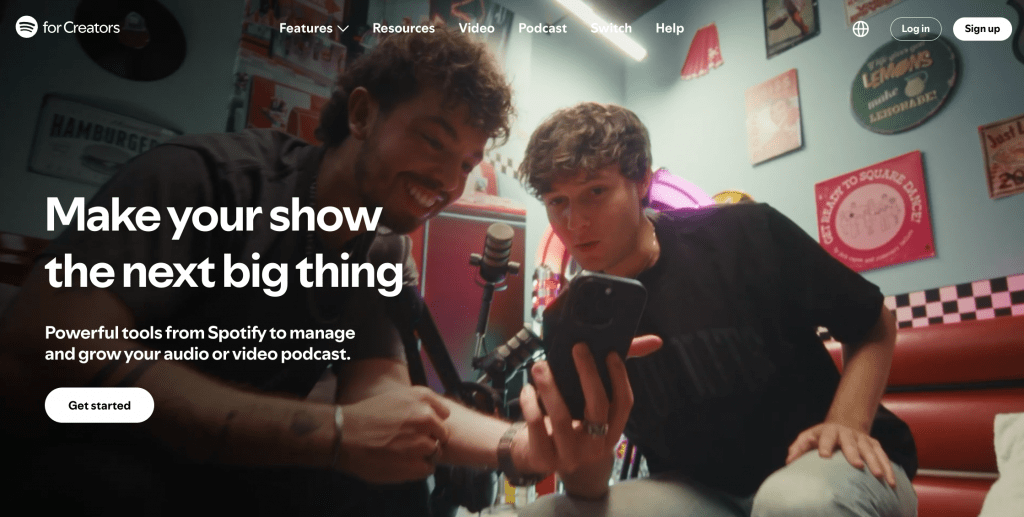
Spotify for Creators (formerly Spotify for Podcasters, formerly Anchor) is a free option that many new podcasters consider when starting a new podcast.
The truth is that Spotify for Creators is a great option for those who are not fully invested in their podcast.
Spotify for Creators is not a good option if you plan on:
- Starting a podcast for your brand or business
- Plan on turning your podcast into a business in the future
While their “free” plan may sound like a good deal, we suggest performing more research on the pitfalls and limitations of using a free service like Spotify for Creators.
When you pay for a podcast hosting service, you are in full control of ads, your content, and your podcast on the major directories like Apple Music, Amazon Music, YouTube Podcasts, etc.
Ideal for: a brand new or uncommitted podcaster still testing the waters.
Spotify for Creators Review – Should You Host Your Podcast with Spotify?
Creating an account and uploading an episode is straightforward. We appreciated the ability to share new episodes to Facebook or X, copy the episode link, or convert the episode into a blog post. The app is intuitive and has useful features.
However, hosting your podcast on Spotify for Creators isn’t without its downsides.
PROS
- Intuitive app
- Unlimited hosting and episodes
- Analytics from Spotify
- Automatic distribution to Spotify, Apple, Pocket Casts, Overcast and others
- Monetization options
- In app recording and editing features
- Cover art creator
- Music integration: Add any full tracks from Spotify to your episodes
CONS
- Fees for sponsorships are higher
- Your show could be removed without warning
- Your content could be used to promote/advertise Spotify without consent or compensation
- Some users have complained that they can’t gain direct access to their analytics on Apple Podcasts because of the automatic distribution
- Their stats are mediocre at best, especially considering that they have direct connection to Spotify and know the demographics of listeners!
- On January 2nd, 2025 Spotify discontinued their Listener Support program, meaning if you have an issue, you could be waiting a long time for it to be resolved.
The Downsides to Spotify for Creators
If you get sponsored, expect to pay a lot more in fees. For example, Spotify for Creators Sponsorship charges “cash out fees” in addition to their 30% cut.
This means if you earn $10 with Spotify, they will take $3, and a $0.25 processing fee as well as a $0.25 cash out fee leaving you with just $6.50.
While it is true they state you own the rights to your content, they also explicitly state in their terms and conditions that by using their platform you grant them the right to edit and modify your content and use it to promote and advertise their company and Spotify.
They also state that they have the right to remove your content without warning at their own discretion, and that they “have no responsibility or liability for the deletion or failure to store any User Content maintained or uploaded by the Services.”
As many podcasters have so aptly put it – If you’re not paying for the product, you are the product.
Because they are a completely free service, customer support is not as robust as you’d receive with another podcast host, and technical issues can go unresolved for long periods of time.

 |  | |
|---|---|---|
| Privacy and Security | Enhanced privacy and security features to protect your content and data. | Standard privacy and security features. Want proof? See this recent article. |
| Control Over Your Content | You maintain full full control over your content. | Your podcast can be deleted without prior notice. Want proof? See this thread and check out this article. |
| Monetization Options | Multiple monetization options including Programmatic Ads Inserted Dynamically (with just 10 downloads!), Apple Podcasts Subscriptions, Sponsorship opportunities and Podcasting 2.0 Value4Value. | Limited monetization options only through ads. And, podcasters only eligible for ads after 100 listeners in a 60 day period |
| Advertising Control | Full control over ads and sponsorships. | Ads are controlled by Spotify, with less flexibility for the podcaster. |
| AI Features | Convert your audio episodes into engaging videos using our PodViz technology and enjoy free episode transcripts in all paid plans. | No transcripts or YouTube integration. |
| Value | RSS.com offers a free Local and Niche plan. Paid plans offer competitive pricing for advanced features and dedicated support. | Free, but with limited features and support compared to paid services. |
| Customer Support | Dedicated customer support with quick response times. | Discontinued on January 2nd, 2025. |
| IAB Certified Analytics | Yes. | Nope! |
💡Pro Tip: Already using Spotify for Creators and want to switch? Here’s how to move your show from Spotify for Creators. ➡️ Move your show to RSS.com and get a full 6 months FREE.
4. BuzzSprout

Buzzsprout’s plans range from $19/month for up to 4 hours of audio uploaded per month to $79 per month for up to 35 hours uploaded per month. Optional add-on features for paid accounts include MagicMastering – audio filtering, and transcription at $0.25/minute.
Signing up for an account and uploading an episode for free was simple and intuitive. With that said, we found their monthly subscription rates are way too high for what you get for the money.
Ideal for: an independent podcaster, serious about podcasting.
PROS
- Analytics
- Embedded podcast player for your website
- Ability to manage multiple podcasts under one account
- Unlimited team members can be added to your account
- Free website for your podcast (ads displayed on free accounts)
- Visual Soundbite for sharing your podcast episodes on social media sites
- Monetization options (affiliate program, sponsorships via Popcorn, and audience support programs)
- Free plan includes uploads of up to 2 hrs each month
CONS
- If you have a free account, Buzzsprout will display ads on your public podcast page.
- Free accounts are limited to just two hours of audio a month, and episodes are deleted after 90 days
- Buzzsprout doesn’t offer annual plans. They are strictly month-to-month.
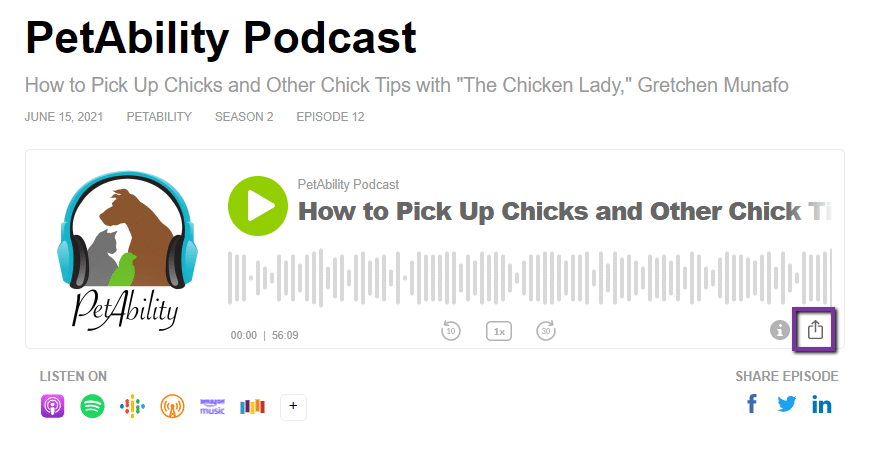
Buzzsprout’s Audience Support Programs
Buzzsprout provides monetization options that allow your listeners to support your show through accounts you’ve set up on Patreon, Podfan, Buy Me A Coffee, Paypal, and Cash App integrations.
In theory it sounds great, however to find the “Support Podcast” button, visitors listening to your episodes need to click a tiny icon hidden in the bottom right of your player to expand and display this feature (see above screenshot).
 |  | |
|---|---|---|
| Content limitation | Your episodes stay hosted without any time limitations. | On the free plan, your episode will only be live just for 90 days. |
| Bandwidth | 1 TB / month | 0.5 TB / month |
| Value for Money | RSS.com offers a free Local and Niche plan, and competitive pricing on paid plans, from $11.99 to $18.75 | Buzzsprout’s paid plans range from $19 to $79 per month with no discounted annual billing. |
| AI features | AI features like, audio-to-video conversion and episode transcripts, comes included on our paid plans. | AI features range from $6 to $30 per month plus the paid plan. |
| Monetization | Programmatic Ads Inserted Dynamically (PAID) with a 70% revenue share once you hit 10 downloads | Ads only eligible on episodes that are 23 minutes or longer, and requires 1,000 downloads in 30 days |
| IAB Certified Analytics | Yes | Yes |
Pro Tip: Already hosted with Buzzsprout? Here’s how to move your show to another host. ➡️ Move your podcast to RSS.com and get a full 6 FREE months!
5. CoHost

Built by Quill, the award-winning podcast agency, CoHost is a podcast hosting and analytics platform for podcasters, brands, and agencies. CoHost has all the data you need to understand your audience and measure the reach, growth, and impact of your podcasts.
One of the best things about CoHost is their Analytics Prefix, which provides in-depth audience insights and data regardless of your hosting setup. Currently available with Advanced Audience Demographics, B2B Analytics, and Tracking Links, CoHost’s Prefix simply integrates with your existing hosting platform.
Some of CoHost’s key features include:
- Advanced Audience Demographics: Verify if podcasts are reaching your target audience by gaining insight into your listeners’ age, income, family, lifestyle, hobbies, social media habits, and more.
- B2B Analytics: Discover which companies your listeners work at and their industry, size, location, average revenue, and job role and seniority level through an exportable list.
- Tracking Links: Track clicks to downloads across marketing channels, all through one single link. Discover top download sources, individual link analytics, and a consolidated LinkTree-style display.
- In-Depth Analytics Dashboards: Dashboards include show and episode consumption rates, growth rates, top episode vs. latest episode insights, and downloads and unique listener data.
- Automatic Transcriptions: An AI-powered transcription tool for effortless editing, distribution, boosted SEO, and accessibility.
PROS
- Unlimited storage and no download limits
- Focus on in-depth podcast analytics and data
- CoHost’s Prefix provides users with advanced podcast analytics, regardless of their hosting provider.
- Insert pre and post-roll audio into your podcast to monetize and dynamically edit your content
- Separated downloads and unique listener dashboards to compare listener data
- Unlimited multi-show management and team members within your account
- Customizable websites and embeddable podcast players
- IAB certified
CONS
- Video podcast hosting is in development
- No mobile app
- Currently, no mid-roll ad insertion is available
 | ||
|---|---|---|
| Pricing | Affordable plans from FREE! Paid plans range from $11.99 to $18.75/month | Higher price point with fewer included features starting at $31/month |
| Video Capabilities | Convert audio to video for YouTube on all paid plans | Video podcast hosting still in development |
| Mobile Experience | Optimized mobile interface | No mobile app available |
| Free Features | Transcripts and YouTube conversion included in paid plans | Many features require additional payment |
| Monetization | Programmatic ads with 70% revenue share and low qualification threshold (10 downloads!) | Limited to manual pre-roll and post roll ad insertion without built-in advertiser marketplace |
| User Interface | Intuitive dashboard for beginners | More complex interface with steeper learning curve |
| IAB Certified Analytics | Yes | Yes |
6. Castos

Castos offers both monthly and annual plans which begin at $19/month and $190/year respectively. Similar to Blubrry, they have a WordPress plugin which allows you to manage your podcast, from inside your WordPress dashboard.
Where they stand out is they are one of the few podcast hosts to offer plans that include video hosting. However, their big features also come with larger price tags.
PROS
- Unlimited number of podcasts – each podcast gets its own RSS feed.
- Unlimited episodes can be uploaded each month.
- Private subscribers option (individuals receive a password to listen to a private feed).
- Free public website for your podcast.
CONS
- Episodes are limited to a 4 hour duration limit.
- The hosting fees are high compared to other hosts, and only the most expensive plan has video hosting.
Castos Podcast Hosting Review
For the lowest paid plan ($19/month) you get 100 private subscribers. At the $490/year pricing tier your private subscribers can be increased to 250, your show can be video published to YouTube and you get Headliner Audiograms for your episodes.
The $990/year pricing tier gets 500 private subscribers, all of the above mentioned features, advanced analytics and video file hosting.
For podcasters with multiple shows, they may be tempted to purchase one of these plans. But in our opinion, it’s a very large fee if you only have one show.
On the other hand, if you want to have a private show that you sell access to, such as in a course or coaching membership, paying for private hosting may be worth it to you as well.
There is a free 14-day trial on the Castos website with no credit card required.
When you sign up, you get the option to either manage your show with their dashboard, or use a WordPress plugin to sync episodes from your WordPress website to Castos.
The Castos dashboard was reminiscent of the BuzzSprout dashboard, and creating an account and uploading episodes was pretty easy. You can also integrate your podcast with Spotify and Amazon Music directly from your Castos account.
Again though – we couldn’t help feeling that the price was just too high for the features offered.
 |  | |
|---|---|---|
| Pricing | Affordable plans from free to $18.75/month | Expensive plans starting at $19/month, up to $4990/year |
| Episode Duration | No limits on episode duration | 4-hour duration limit on episodes |
| Video Capabilities | Convert audio to video for YouTube on all paid plans | Video hosting only available on the most expensive plan |
| Multiple Shows | Manage unlimited shows for a flat fee | Unlimited shows but at much higher price points |
| Monetization | Podcasters eligible to implement Programmatic Ads Inserted Dynamically (PAID) with a 70% revenue share after 10 downloads directly from their dashboard | You have to request access to Castos Ads and you can’t choose your ad categories |
| AI Features | Free transcripts and audio-to-video conversion included with all paid plans | Limited AI features without additional cost |
| IAB Certified Analytics | Yes | No |
7. Libsyn
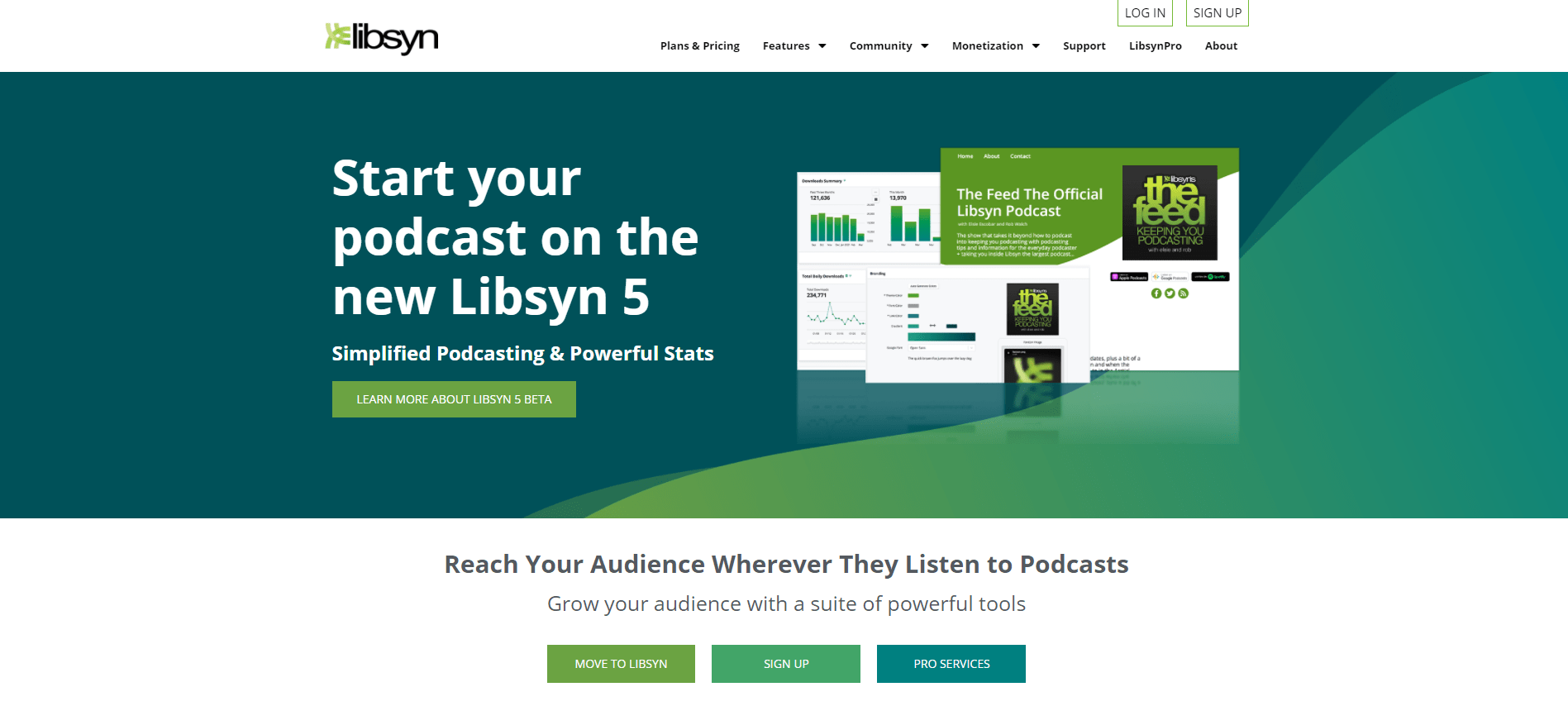
Libsyn’s claim to fame is that they host more than 75,000 podcasts worldwide, and packages start at just $5/month.
The question is – what features do you get for that $5/month? Let’s explore.
PROS
- Inexpensive hosting. Plans start at just $5
- An RSS feed to submit to podcast directories.
- Public website for your show. You can also use your own domain for an additional $2 per month.
- Listing on Libsyn’s podcast directory.
- WordPress plugin for publishing episodes on WordPress
- Embed Codes to add episodes to your website
CONS
- At $5 you only get 50MB of storage/month (single episodes can be bigger than that!)
- Analytics aren’t included for the $5/month plans.
- Their app is restricted to the $20 and up plans.
- Your podcast cover art counts towards your monthly storage.
Libsyn Podcast Hosting Review
If you have an episode that is an hour or longer, you will hit storage quotas fast. And, if you have multiple episodes you want to load in a single month, you’ll need a more expensive plan as well.
The most expensive plan that is publicly available is $40 per month and it features 800 MB of monthly storage. While these numbers reset each month for how much you can load, we’re betting you will find it’s far too easy to hit their maximums once you start getting serious about podcasting.
Analytics begin at the plans that are $15/month and up. Other features such as Double Opt-In Advertising and MyLibsyn Premium Paywall aren’t available until you reach the $20/month plan. The Paywall feature allows you to charge premium subscription fees for your podcast content.
In terms of loading and deleting episodes, as well as creating your account, Libsyn is easy enough to use. Again though, we can’t help but gasp at their storage limitations.
 | ||
|---|---|---|
| Storage | Unlimited storage on all plans | Very limited storage (50MB on $5/month plan) |
| Analytics | Analytics included in all plans | Analytics not included in basic $5/month plan |
| Cover Art Storage | Cover art doesn’t count against storage | Cover art counts toward monthly storage limit |
| Episode Size Limits | No episode size restrictions | Episode size restricted by monthly storage limits |
| Mobile Access | User-friendly mobile interface | App restricted to $20+ plans |
| Monetization | Start earning with PAID programmatic advertising – qualify with only 10 downloads and keep 70% revenue | Top tier advertising limited to shows with 20,000 downloads; Automatic Podcast Ads available to all |
| AI Features | Free transcripts and YouTube video conversion | No comparable AI features |
| IAB Certified Analytics | Yes | Yes |
8. Podbean
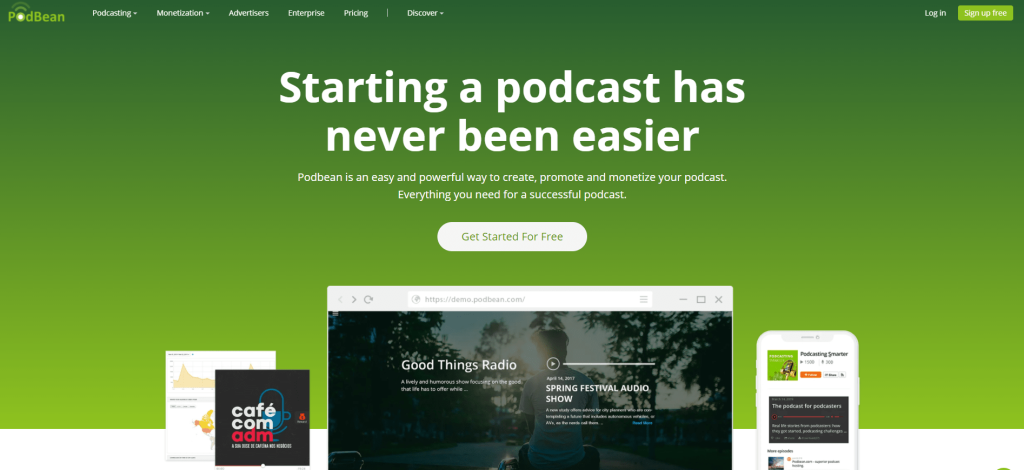
PodBean offers both free and paid accounts to podcasters. They also offer a unique feature with their unlimited plus and business plans known as the Patron Program.
The Patron Program is a paywalled RSS feed that allows you to charge your listeners to receive access to bonus content that is not available publicly.
PROS
- PodBean offers a free podcast plan that includes 5 hours of total audio, and 100GB of monthly bandwidth.
- Mobile app and podcast player.
- Embeddable players to add your episodes to websites.
- A public podcast website with free themes.
- Podcast RSS Feed.
- Basic stats for your podcast.
CONS
- Limitations on storage and bandwidth for free accounts.
- Other podcasters have complained of glitches with their website, and difficulty adding their RSS feed to podcast directories.
- Only business plans have the ability to remove Podbean branding from podcast pages.
Podbean Review
Paid accounts begin at $9/month (paid annually) or $14/month (paid monthly). As soon as you begin paying you get additional features including:
- Advanced Stats such as “where your audience comes from [and] how they play your episodes”
- Unlimited storage and bandwidth (“subject to Podbean’s Fair Usage Policy)
- Pro Themes for your public podcast web page
- Custom design options
- Opportunities to monetize with Ads Marketplace and Premium Sales
For even more features such as access to their Patron Program, and/or PodAds monetization opportunities as well as video hosting, you will need an Unlimited Plus plan (starting at $29/month) or a Network plan starting at $79/month.
Business plans also gain access to private podcasts, groups, live chat support, and the Podbean Pro App.
Sign up was easy, and accessing the dashboard was simple as well. One feature that was interesting was the automatic social share option. You can connect your Facebook, Twitter, and LinkedIn accounts to automatically share new episodes upon their release.
You can also record and publish an episode from within the app for the platform. However, again we highly recommend recording with a podcasting microphone into a program like GarageBand or Audacity, and then uploading it for better audio quality.
 |  | |
|---|---|---|
| Free Trial | Feature-rich free Local and Niche plan with no time limit, and unlimited episodes | Free plan limited to 5 hours total content and basic features |
| Reliability | Consistent performance without reported issues | Users report glitches with website and RSS feed issues |
| Analytics | Comprehensive analytics on all plans | Advanced stats only on paid plans |
| AI features | Free transcripts (with paid plans) and YouTube video conversion (YouTube integration available with paid plans) | No comparable AI features included |
| Monetization | PAID (programmatic ads inserted dynamically) accessible at just 10 downloads with competitive 70% revenue split | PodAds require 1,000 downloads per month and charge a fee of $1 per 1000 ad impressions (CPM) |
| IAB Certified Analytics | Yes | Yes |
9. Simplecast
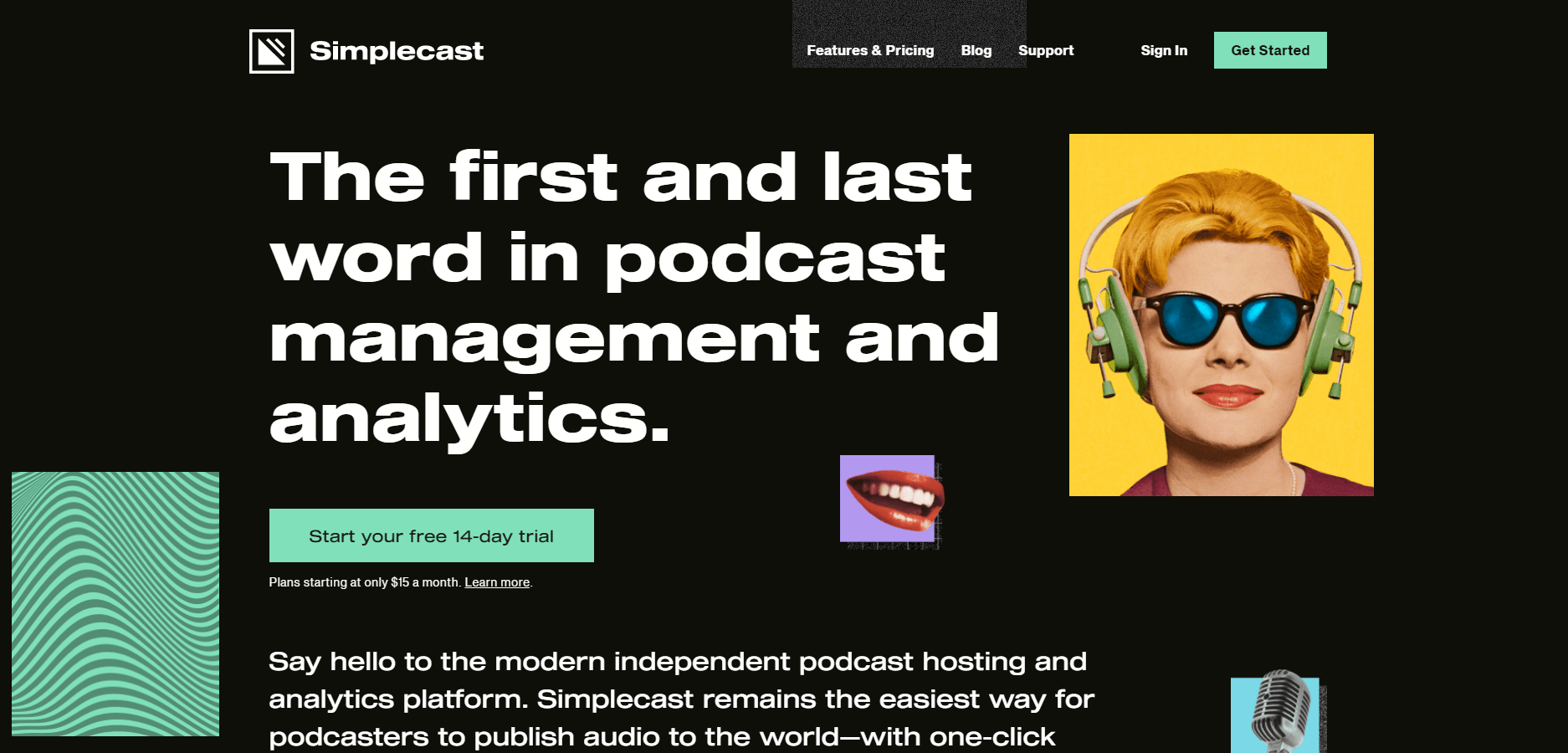
Simplecast touts itself at the best platform for podcasters who want to track their analytics. Unfortunately, you will need to choose the higher pricing tiers to gain access to them as their lowest priced plan only delivers “Basic analytics.”
Simplecast’s free trial is for 14 days, and that will give you carte blanche to explore it’s interface and features. That is until you want to actually publish an episode at which point, you’ll need to select a paid plan. Plans begin at $15/month if paying month-to-month or $13.50 if paying annually.
PROS
- Signing up doesn’t require a credit card.
- Paid plans include unlimited uploads and storage.
- Basic analytics included with paid plans.
- Embeddable podcast player to share episodes on your website.
- A public podcast website for your show.
- Podcast RSS feed.
CONS
- The free trial isn’t really a full trial – you can’t upload an episode until you pay.
- With the basic plan you are capped at 20,000 downloads per month.
Simplecast Podcast Hosting Review
If your show goes viral and takes off, having the basic plan can be problematic!
The next tier jumps to $35 monthly ($31.50/month if paying annually), and it only permits 50,000 downloads per month. Finally, their growth plan is $85 monthly, and it allows for up to 120,000 downloads per month.
While the platform seems easy to use, we can’t help feeling like the pricing structure encourages podcasters to stay small lest they end up having to pay huge podcast hosting fees.
Call us crazy, but we don’t think podcasters should get penalized for their shows gaining popularity!
 | ||
|---|---|---|
| Download Limits | Unlimited downloads on all plans | Strict download caps (20,000 on basic plan) |
| Pricing Structure | Affordable plans ($0-$18.75) with no penalties for growth | Expensive plans with penalties for popularity ($15-$85/month) |
| Free Trial | Functional free trial that allows publishing | Limited free trial – can’t upload until you pay |
| Storage | Unlimited storage on all plans | Unlimited storage but capped downloads |
| AI features | Free transcripts and YouTube video conversion included (with paid plans) | No comparable AI features |
| Monetization | Podcasters on paid plans can monetize almost instantly via PAID programmatic ads – low 10-download barrier, high 70% revenue share | Access to Simplecast’s Ads is only available with their pro and enterprise plans with no clear info on how to earn revenue |
| Growth Compatibility | Designed to scale with your podcast success | Structure discourages growth with high-tier pricing |
| IAB Certified Analytics | Yes | Yes |
10. Spreaker
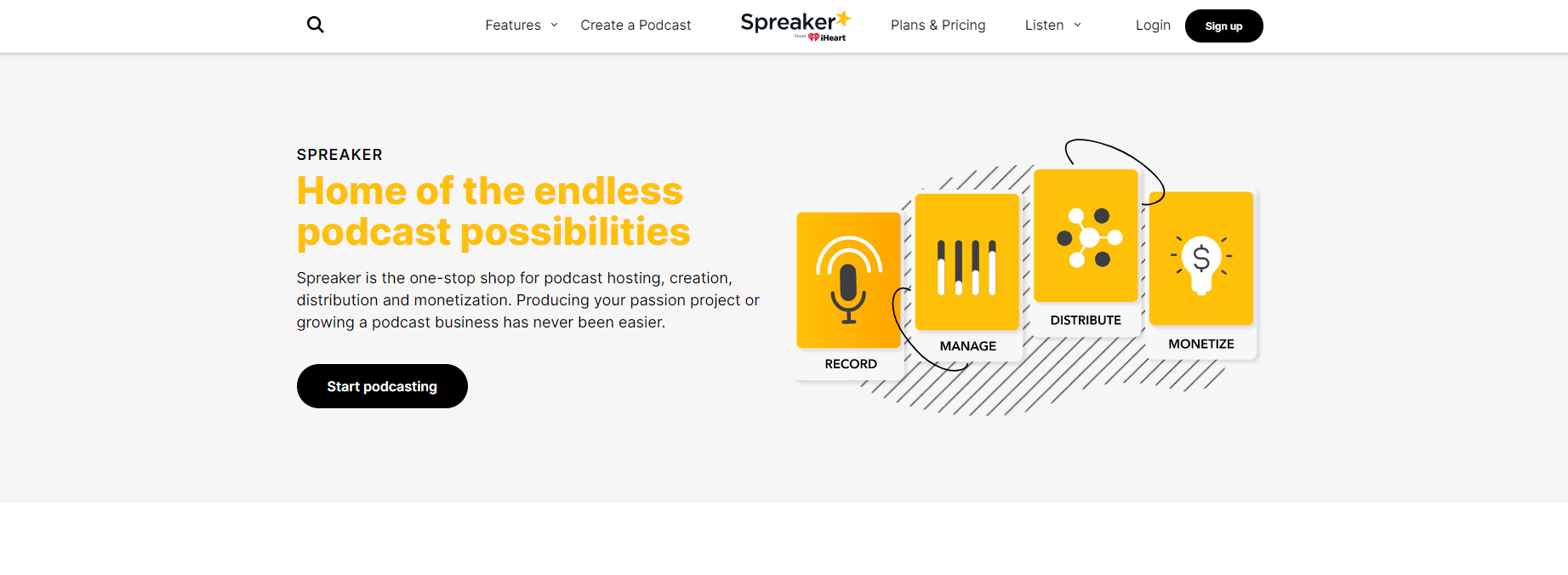
Spreaker is owned by iHeartMedia, which acquired Voxnest, Spreaker’s parent company, in October 2020.
Spreaker is one of the few podcast hosts that allows live broadcasting, making it ideal for interactive, call-in style shows.
PROS
- Free accounts are available with limited features, allowing users to get started without a credit card. The free plan offers unlimited episodes
- Live podcasting is available on all paid plans, with live broadcasting limits increasing on higher-tier plans
- Monetization through ad revenue sharing and dynamic ad insertion is available on all plans. Paid plans can also charge for subscriptions.
- Users can manage multiple podcasts on a single paid account, which is a great feature for networked podcasts.
CONS
- Limited features on the free plan. Even the lowest-tier paid plan (the Broadcaster plan, at $20/month) offers limited live podcasting and basic statistics
- Some customer complaints on review platforms mention difficulties with customer service
- Spreaker customer complaints on G2 included:
- “Worst Customer Service. Hands down.”
- “Refuse to refund an auto-payment made in error to 2 year customer.”
- “They will bill you a renewal without warning for a year in advance and then flat out will not refund the pre-payment, even if you have moved your podcast a year ago! “
 |  | |
|---|---|---|
| Content limitation | Unlimited storage for your podcast episodes. | Free plans can upload up to 5 hours of audio content. |
| Episode Length Limits | Freedom to create episodes of any length. | Imposes duration limits on episodes. |
| Monetization | PAID (programmatic ads) accessible on all paid plans starting at just 10 downloads with competitive revenue sharing of 70% | Ad revenue sharing only on plans $20+/month with limited features |
| Advanced Analytics | Access to advanced analytics without the hefty price tag. | Spreaker’s advanced analytics are available on plans starting at $20/month. Full analytics are only available on the $50 and $250 plans |
| Feature-Rich Packages | Affordable plans offer advanced analytics, audio-to-video conversion, and a public website. | Advanced analytics only on paid plans. Does not include audio-to-video conversion. |
| IAB Certified Analytics | Yes | Yes |
Spreaker Podcast Hosting Review
Spreaker’s paid plans begin with their “Broadcaster” plan at $20/month. At this price point, users gain access to the following features:
- Up to 100 hours of audio storage.
- Unlimited episodes and listeners.
- Episode scheduling.
- Up to 45 minutes of live podcasting with a listener’s chatbox to engage with your audience.
- Basic statistics.
- Ad revenue sharing and dynamic ad insertion monetization opportunities.
Spreaker’s “Anchorman” plan starts at $50/month and gives you access to up to 5 hours of live podcasting.
They also offer a “Publisher” plan at $250/month. Both the “Publisher” and “Anchorman” plans provide “Full Statistics.”
11. Transistor.fm

Similar to RSS.com’s Podcast Networks Plan, Transistor is designed for businesses and networks that want to host multiple podcasts under one account.
Pros
- Ability to host unlimited podcasts and add unlimited team members under one account.
- Intuitive dashboard for managing multiple shows.
- Built-in website builder for each podcast.
- Advanced analytics and insights.
- Dynamic ad insertion, show notes and YouTube auto-posting for monetization.
- Option to have private podcast subscribers.
Cons
- No free plans available.
- Transistor limits your downloads.
- Limited to English, Spanish and Portuguese languages.
- Expensive when compared to other platforms
- No unlimited plans.
 |  | |
|---|---|---|
| Value for Money | Competitive pricing and feature-rich plans ranging from $0 to $18.75. | Plans start from $19/mo for Starter, $49/mo for Professional, and $99/mo for Business. |
| Monetization | Programmatic ads available at just 10 downloads and 70% revenue share | Monetization capped by download limits on expensive plans that penalize growth |
| Downloads limitation | Unlimited downloads for wider reach. | Monthly download limits of 10,000, 50,000, and 150,000 respectively for each plan. |
| Enhanced flexibility | AI features like audio-to-video conversion and episode transcripts, comes included in all plans. | AI features range from $5 to $20 per month plus the paid plan. |
| IAB Certified Analytics | Yes | No |
Transistor Podcast Hosting Review
While Transistor makes it easy for businesses and networks to host and manage multiple podcasts from one account, the biggest downside is how expensive it is. Sure, you could save some coin and opt for the annual Starter plan. But, even with the savings it still comes in at just over $15 a month, and you’re limited to 20,000 monthly downloads.
Even with their most expensive plan at $99 per month, you’ll be limited to 250,000 monthly downloads. Unless you have some specific needs, there’s no reason for you to pay $19.99/month with Transistor.fm when you can pay $0 to $18.75/month using RSS.com
Bottom line – though the interface is easy to use and they have some similar bells and whistles, you can get more bang for your podcasting buck with RSS.com.

How to Choose a Podcast Hosting Platform That Perfectly Meets Your Needs and Budget
We’ve covered a lot in this post, and we understand you have options when choosing a podcast host.
Here are a few steps to take to assist you in making your choice:
Step 1. Open a word processing document or get out a pen and paper.
Step 2. Write down what your short-term and long-term goals are for your show.
Step 3. Write down how often you plan to release episodes, and how long you intend for them to be.
Step 4. Decide if you plan on hosting just one show or multiple shows?
Step 5. Decide if you plan on video podcasting?
Step 6. Write down your budget.
Let your answers help guide who you ultimately choose as a podcast host. For example, if video hosting is a top priority, many options on this list will be instantly removed.
We will say that we believe RSS.com has changed the podcast hosting game by offering the industry’s most generous free plan. With unlimited episodes and storage on the free Local and Niche plan, new podcasters can start without any financial risk.
As your show grows, you can upgrade to access programmatic advertising, Apple Subscriptions, and multi-show management for as little as $11.99/month (paid annually). It’s hands down one of the most flexible and affordable hosting options at every stage of your podcasting path.
That said, you can always take advantage of free trials and offers to test the features and functionality of the podcast hosts on this list before making your final decision.
With a little searching, there are coupon codes and links for free trials for nearly every podcast host listed above.
In fact, RSS.com has a coupon code for a full free month. Just use RSSFREEMONTH at checkout.

